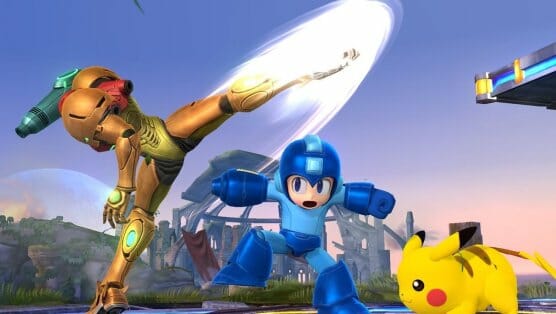Super Smash Bros. for Wii U: Stimulation Overload

Super Smash Bros. for Wii U requires a lot of investment. I’ve been playing Smash Bros. since the first iteration came out on the Nintendo 64 in 1999, so I’m definitely invested, but this game doesn’t necessarily require any familiarity with prior entrants in the series. On the contrary, Smash is a matter of taste; the game’s colorful, overstimulating absurdity make it unlike any other fighting game, and thus, it has grown into a divisive franchise with a particularly defensive fanbase. The button combinations required to master any Smash character are notoriously simple in comparison to other fighting games, not least because every character has more-or-less the same move-set. The barrier to entry here is the game’s atmosphere. If you don’t like it at face value, you’re not going to stick around long enough to find out why Smash is anything special.
I briefly lost my faith in Smash this year when Nintendo chose to release a new version of Smash for the 3DS handheld before allowing me to play the game as intended, on a TV screen with a comfortable controller. Squinting at my 3DS screen, wishing I could actually see the game, and discovering little to write home about in terms of new features, I worried that the Wii U release would disappoint me as well. On the contrary, this new version makes the 3DS port feel like so much perfunctory fluff.
The main addition to the basic competitive structure of Smash Wii U is the presence of the customizable fighters, particularly the Mii Fighters. These existed in the 3DS version, too, but no character looked or felt good on that tiny screen. These fighters look significantly better in high-definition, and customizing their outfits and moves feels good with the Gamepad and TV set-up. This game may have been the first game to help me understand why the Wii U’s Gamepad even exists; typing in different character names with the stylus, tapping on hair colors and eyebrow shapes, and scrolling through the selection menus felt much easier with the pad than with a traditional controller.
Smash Wii U also allows you to create customizable versions of the in-game characters, so you can create a Mario who’s a little less powerful in favor of getting a higher jump or a speedier gait. (You can customize Amiibo versions of these characters, too.) All of these customizations are significantly easier to see and understand now that the game is actually on a TV. Does it seem like I’m emphasizing this “TV” thing a lot? That’s because I’m still mad that anybody would try to put this game on a 3DS. Seriously.
Speaking of character customization, there sure are a lot of mini-games that allow will you to unlock new items, costumes and props in this game, not to mention trophies and other virtual paraphernalia. In addition to the usual Smash multiplayer fighting modes, there’s the “Smash Tour,” a board game inspired mode in which Mii Fighters collect items, power-ups and buffs, then duke it out as whatever Smash characters they manage to enlist in their journeys around the board.
Under the game’s “Challenges” and “Games & More” sub-sections, you’ll find yet more feats of strength to butt your head up against in the name of attaining more in-game items. All of these modes include two-player co-operative versions as well as solo modes, each of which will unlock different collections of prizes upon completion. The best prizes are goofy hats for your Mii Fighters; I don’t know about you, but putting a tiny red top hat or a pink hibiscus flower onto a Mii delights me. Even if you aren’t invested in all the different spoils and winnings, though, the “Challenges” and the “Events” modes will provide many a frustrating battle or puzzle.
The rest of the mini-games serve more as charming entertainment. There are gambling mini-games with “Master Hand” and “Crazy Hand” (it’s not real money, so it’s not exactly gambling, but Mii hats are serious business), an Angry Birds-like game called Target Blast, the Multi-Man Smash (fight a bunch of guys), the Home Run Contest (hit a sandbag as far as you can with a Smash attack), and the All-Star Mode (fight as many characters for as long as you can, with only one life and no health recovery).
In previous version of Smash, many of the characters and extra modes were kept sealed away until players had battled through enough multiplayer matches to unlock them. In this version of Smash, the Party Ball cracks open as soon as you boot up the game. Some of the characters are withheld at first, but not as many as were even in the 3DS version—you only have to play through 100 matches before you’ve got everybody. Also, there really aren’t any new characters to spoil here, given that you already saw all the new faces in the 3DS release. The immediate availability of all of these mini-games, modes and characters felt like a direct IV of pure, undiluted Smash—a sorely needed dose for me, after I’ve spent so long feeling frustrated about the slim pickings on my tiny 3DS screen.
-

-

-

-

-

-

-

-

-

-

-

-

-

-

-

-

-

-

-

-

-

-

-

-

-

-

-

-

-

-

-

-

-

-

-

-

-

-

-

-









































